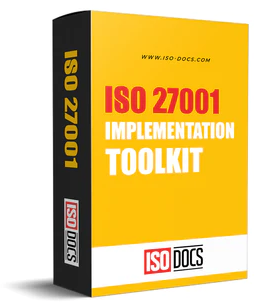How To Get ISO 27001 Certified
In today's digitally interconnected landscape, safeguarding sensitive information has become a mission-critical endeavor for organizations of all sizes and industries. The ISO 27001 certification, renowned globally for its emphasis on robust information security practices, offers a systematic framework to establish, implement, and continually improve an Information Security Management System (ISMS).
This comprehensive guide navigates you through the intricacies of obtaining ISO 27001 certification, providing insights, steps, and considerations to ensure a successful journey toward fortified information security.

1. Understanding ISO 27001: Laying the Foundation
Before embarking on the certification journey, it's vital to comprehend the essence of ISO 27001. This internationally recognized standard outlines the requirements for creating an effective ISMS designed to protect sensitive information, ensure its integrity, and maintain its availability. The ISMS is a strategic approach that encompasses people, processes, and technology to manage information security risks holistically.
2. Conducting a Preliminary Assessment: Identifying Readiness
The initial step involves gauging your organization's current state of information security readiness. Conduct a preliminary assessment to evaluate existing policies, procedures, controls, and practices against ISO 27001 requirements. This assessment identifies gaps and areas that need improvement, offering a roadmap for the certification journey.
3. Establishing a Project Team: The Champions of Certification
Form a dedicated project team responsible for steering the ISO 27001 certification process. This team should comprise individuals from various departments, including IT, legal, compliance, and operations. Their collective expertise and commitment will drive the successful implementation of the ISMS and ensure its alignment with organizational goals.
4. Scoping the ISMS: Defining Boundaries and Objectives
Clearly define the scope of your ISMS by identifying the boundaries within which information security will be managed. Outline the objectives of the ISMS and establish measurable goals. This scoping exercise provides clarity, ensuring that efforts are focused and resources are allocated effectively.
5. Conducting a Risk Assessment: Identifying and Prioritizing Risks
A comprehensive risk assessment is at the heart of ISO 27001. Identify potential risks and vulnerabilities that could impact the confidentiality, integrity, and availability of your organization's information assets. Evaluate these risks based on their potential impact and likelihood. This assessment forms the basis for selecting appropriate controls to mitigate the identified risks.
6. Risk Treatment and Control Selection: Building the Defense Mechanism
With risks assessed, it's time to develop a strategy for risk treatment. Select and implement controls from Annex A of the ISO 27001 standard that align with the identified risks. These controls encompass various domains, such as access control, cryptography, and incident response. Implementing controls is pivotal for fortifying your organization's information security posture.
7. Developing Policies and Procedures: Crafting the Framework
Translate the selected controls into policies, procedures, and guidelines that form the foundation of your ISMS. These documents define how information security will be managed, communicated, and practiced across the organization. Clear and concise documentation fosters consistency and ensures everyone understands their roles in safeguarding information.
8. Training and Awareness: Nurturing a Security Culture
Equip your employees with the knowledge and awareness needed to uphold information security practices. Training programs educate staff about the importance of information security, the ISMS policies, and their responsibilities. Fostering a security-conscious culture empowers every individual to be a guardian of sensitive information.
9. Conducting Internal Audits: Assessing ISMS Effectiveness
Internal audits evaluate the effectiveness of your ISMS and its alignment with ISO 27001 requirements. These audits identify gaps, areas for improvement, and potential non-conformities. Regular internal assessments instill confidence in the ISMS's robustness and provide insights for continuous enhancement.
10. Management Review: Senior Leadership's Involvement
Engage senior management in a comprehensive review of the ISMS's performance. This review evaluates the ISMS's alignment with organizational objectives, its effectiveness in managing information security risks, and the need for any adjustments. Senior leadership endorsement underscores the strategic importance of information security.
11. External Certification Audit: The Culmination of Efforts
Engage an accredited certification body to conduct an external audit of your ISMS. This audit evaluates the extent to which your organization complies with ISO 27001 requirements. The certification body's independent assessment validates your information security efforts and serves as the gateway to ISO 27001 certification.
12. Certification Decision: Attaining ISO 27001 Recognition
Based on the audit findings, the certification body makes a decision regarding ISO 27001 certification. Successful certification affirms your organization's commitment to robust information security practices and compliance with international standards. The ISO 27001 certification is a testament to your dedication to protecting sensitive information.
13. Continuous Improvement: Sustaining Excellence
ISO 27001 is not a destination; it's a journey of continuous improvement. Regularly review and enhance your ISMS to adapt to evolving threats, technologies, and business needs. Embrace feedback, conduct periodic risk assessments, and implement lessons learned to ensure your information security practices remain resilient.
Conclusion: Empowering a Secure Future
ISO 27001 certification isn't just a badge of honor; it's a strategic asset that empowers organizations to navigate the complex realm of information security with confidence. By following this comprehensive guide, you embark on a transformative journey that enhances your information security posture, builds stakeholder trust, and positions your organization as a guardian of sensitive data in an increasingly interconnected world. As you navigate each step, remember that ISO 27001 certification is not merely an achievement—it's an ongoing commitment to safeguarding the digital foundation on which your organization thrives.


